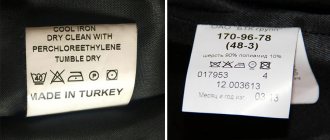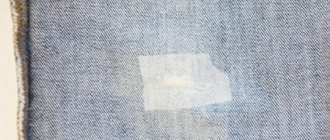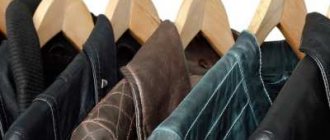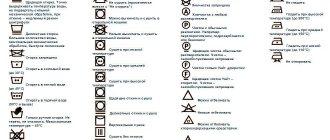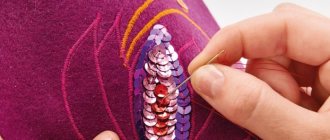Machine hem sequence
So, the length has been chosen. Now you need to carefully trim.
- First, fold both halves of the trousers together and place them on the table.
- Pin along the sides, along the waistline, so that they do not move.
- Measure the required length and draw a thin strip with chalk.
- Step back 2-3 cm from the selected length and again draw a strip with chalk. (If the material is too thin, then step back 4-4.5 cm).
- Cut off the excess.
- Fold, baste with stitches, stepping back from the bottom by 5-6 millimeters. Then make another basting stitch.
- Then connect both trouser legs to double check that the hem is even.
- Tip: try on the product again so you don’t doubt the length you choose.
- Cut both legs at once; if the material is too thick, cut one at a time.
- Use an overlocker or zigzag stitch along the cut edge.
- If you did everything correctly, fold it, iron it through gauze, and sew it on a machine.
- Remove the basting and iron it.
Shorten pants without cutting
There are several ways that allow you to change the length of your pants without the intervention of scissors. Let's consider the main ones:
- Classic hand hemming. It is convenient because this option does not require special devices. All you need is a thread and a needle.
- On a sewing machine. This option differs significantly from the first in execution speed. For reliability, it is possible to use a double seam even on trousers with thick fabric.
- Using adhesive tape. This method can be used in cases where the length needs to be changed slightly and in a short time. Moreover, you can reduce the length to the original one.
Materials and tools
To hem your trousers yourself, you will need:
- sewing machine;
- needle;
- threads (it is important that they match the color of the fabric);
- the trousers themselves;
- a piece of soap or chalk;
- scissors;
- ruler, maybe a measuring tape;
- trouser braid;
- pins.
Preparing the trousers
First you need to figure out the size of the hem. Wear the trousers and shoes with which you plan to wear this item. Fold the bottom of the product so that approximately 1 - 1.5 centimeters remain to the floor. Secure with needles. Try walking around the room, sitting on a chair several times so that the clothes rise to their usual height.
Ideally, the trousers should reach the middle of the heel. Highlight with chalk. Do the same steps with the second pant leg.
Hem trousers without cutting them by hand
First option:
After you have placed the very bottom of the trousers, you need to hem 4 millimeters with a straight stitch. Make a fold on the trouser leg so that the length is exactly at the level of the mark.
IMPORTANT! Make sure that the end of the fabric does not protrude below two millimeters of the fold.
It doesn't have to be ironed. It's better to just pin it with pins. Next, follow the same procedure with the second leg. If you hemmed for growth, then you can easily undo the stitches. If dust accumulates in the folds, you should wash the trousers in warm water or clean them with a brush. Following this, iron the bottom. There won't be a trace left!
Second option:
If you need to tuck a small amount of fabric , you can rip open the factory seam and steam this area. All kinds of creases should be removed using an iron and high temperature.
Set aside 4 cm from the line you created. Based on the first mark, repeat with the second leg. Transfer the line that was drawn with chalk to the next side using pins. Along this straight line, fold the fabric inward and pin. Make sure that the side seams are aligned. A small and thin needle is suitable for sewing. Hem over the edge of the cut using any blind stitch. Use a needle to grab one thread at a time.
You can secure a small hem with adhesive tape by inserting it and applying it with a hot iron.
Correctly hem long trousers without cutting them using a sewing machine
Classic (school) trousers with braid
- To begin with, you should apply the top side of the tape so that it is exactly at the level of the line marked with chalk.
- Then conditionally divide it in half and secure with pins.
- Back off one millimeter.
- Sew the side that matches the chalk line. And only then can you proceed to the bottom.
- You should turn the seam allowance so that it is inside out.
- Don't forget the braid. It should not be visible from the front side.
- Sew the bottom edge yourself or use pins.
- All that remains is to attach the hem to the bottom of the trousers using hidden seams, which will avoid trimming.
- We remove all the basting.
- Finally, we again steam the fabric for a decent appearance.
Jeans
- Fold the trouser leg to a height of one and a half centimeters (two turns).
- Again, remember that the tone of the thread should be observed: it should match the tone of the factory fabric.
REFERENCE! Since we are working with jeans, make a double seam. Sew with a straight stitch.
If you need to preserve the factory seam, then use the following hemming algorithm:
- As in other cases, determine the desired length of the jeans and mark with chalk.
- After measuring the edge, move the mark to the required distance.
- Match the edge and line using the crease of the pants.
- Make a stitch on a sewing machine.
- Thanks to the iron, you can attach the lapel to the pant leg.
- All that remains is to lay the line.
Hemming of thin fabrics
If the trousers are made of silk, chiffon, viscose, then you need to tuck them twice so that the material does not fray. Then iron and machine sew. After basting, be sure to go over it with an iron, this makes it easier to machine stitch.
After removing the basting, you need to iron it again to remove thread marks.
Wool suit trousers cannot be machine stitched. In this case, you also need to fold it twice, baste, iron and hem it by hand. It is important not to leave marks on the front side. Grab only one thread from the front side, then no one will notice the seam.
The sequence of hemming trousers with a hidden seam
For example, for jeans, you can make a visible seam, because this is required by the product model itself. But for classic trousers, a hidden seam is required so that it does not stand out against the general background.
Often craftswomen do not perform an invisible seam because it is difficult. In this case, you can use the services of an atelier. But it’s quite possible to learn how to do it yourself.
Hand-made blind seam
This seam gets its name because it is not visible on the product, as it is hidden between the fabrics. You can take threads 2 tones lower. Shortening process:
Making an invisible seam
- Turn the trousers inside out and secure with pins;
- Check the side arrows, they must be aligned;
- Insert the needle to the other side;
- Sew until the end with a distance of 3 mm.
You might be interested in Interesting patterns of overalls for newborns
The hemming is complete.
We sew trousers with a blind seam on a machine
Fold the excess fabric outward, mark the fold with a marker and secure with pins. If the body is asymmetrical, each leg is marked.
Before work, lay your pants out on the table or floor. The trouser legs are folded seam to seam, the waist line also coincides. To prevent the material from fidgeting, you can pin it with safety pins. Next, the machine is adjusted to the desired seam and work begins.
Working with cobwebs
How to hem a man's trousers
Women's pants require less work than men's pants. But for skillful hands, any work brings only pleasure.
You also first need to decide on the length. Put the man in trousers without shoes first. Baste so that there is a distance of 5-6 millimeters from the floor. Then you need to measure in shoes. The length should reach the heel. If a man wears trousers with a belt, then let him wear a belt.
It is better to treat men's trousers with ribbon, web or braid.
Sequence of work:
- Place the product on the table.
- With chalk, draw a cutting line and a line for the length of the pants, leaving an allowance of 4-5 cm. The thinner the material, the less allowance you need to make for the hem.
- Trim off excess fabric.
- Finish the bottom of the legs with an overlocker.
- Sew the braid 2mm above the hem line.
- Fold both legs, leaving 2mm of tape on the right side. It should “peek out” a little. This is done so that the fabric does not wear out longer when worn.
- Hem the bottom of the legs.
- Using a needle, hook one thread on the front side, then hook it on the hem, then hook the thread further away, and so on until the end.
- After finishing the work, the puncture site with a needle will be completely invisible.
This is what a hidden seam looks like.
How to shorten trousers so that the seam on the front side is not visible?
This method is suitable if you want to fold the bottom:
- for men's or women's suit trousers, they can be either tapered or wide at the bottom;
- school trousers, in which you can leave extra length for growth;
- beautifully shorten jeans without finishing the top;
- if you want to do this at home without a sewing machine by hand.
Many people, looking at the hem of a product, often understand how it was made. But even in the simple version there are some secrets that make the work easier and faster.
The saved time can be spent on creativity, reading books, on family, in the end, on yourself (often there is not enough time for this) and on much more.
This master class will be useful not only for beginning craftswomen. Experienced craftswomen can also find something new for themselves. Practical advice very often helps out, oh, how it helps)))
For work we will need:
- Chalk or soap
- Scissors
- Pins
- Needle
- Threads
- Overlock
- Hook
- Iron
Progress:
- We try on the product, if we wear a belt or a belt, we put it on, because the trousers will rise up a little. If this is not done before hemming, it is very possible that they will be too short.
- We put on shoes and mark the desired length, taking into account desires, fashion trends and the width of the leg. If the trousers are narrow at the bottom, they are hemmed shorter; if the trousers are wide, they are hemmed longer. If you like trousers of medium length and classic width, measure them to the middle of the heel. In front, to avoid creases, you can shorten the front part by 0.5 - 1 cm.
- And so, you marked the desired length with a pin, then mark (bend) the second leg too. For accuracy, you can use a ruler and measure the distance from the floor to the selected length along the first leg, set aside the same amount along the second and bend it.
Why do this? It's no secret that we are not symmetrical and often when hemming trousers, focusing on one leg, in the end we find that they are not equal in the back, one is higher than the other. But I don’t want to redo it, oh I don’t want to)))
- Let's move on. Our product is on the table with the hemming points marked. Photo 1.
- We are not in a hurry to cut, we measure the side seams, photo 2. As you can see, one pant leg is 1 cm longer than the other, photo 3.
In mass-sewn trousers in my practice (25 years), the difference reached 3 cm. I think that in that case the height of one of the legs was mixed up. But if we don’t think about it in advance, it’s up to us to redo it later, not them)))
- With chalk we draw a line along which we will bend, below, retreating 3-3.5 cm, another line along which we will cut. Please note that I took into account the difference in the legs))). Picture 4.
- Take scissors and cut along the bottom chalk line. I advise you to cut it in one layer of material, as it happens that the fabric shifts and the bottom turns out uneven and sloppy. Picture 5.
- Now, we overlock the bottom of the trouser leg with an overlocker, leave the tail longer and tuck the hook into the overlock stitch. Picture 6.
- Our next step will be to mark the bottom along the chalk line. But I suggest you save time and go straight to the iron. For convenience, we turn the trouser leg inside out, put it on the ironing board for the sleeves and fold it along the chalk line and fix it, smoothing it with an iron. Picture 7.
- Next, we thread a thread of a suitable color into a needle and make a cross stitch. We start with the inner seam allowance of the leg (the seam between the legs).
At the seam allowance (the folding part), we pierce the material through the base of the overlock seam (from the wrong side it will look neat). From the side of the trouser leg itself, we grab 1-2 threads of fabric so that there is no trace on the front side. Picture 8 -9.
- The movement of the needle is always from right to left, so in the end you get a cross, photo 10 - 11.
- The finished seam looks as shown in Image 12. A correctly made blind seam (it is not visible) holds up better than a production machine hem seam.
- After going around the leg and securing the end of the seam well, we begin ironing. Steam the bottom of the product. All is ready. Photo 13.
I hope that it was useful for a novice craftswoman to learn the sequence of actions when hemming.
Further, in subsequent articles, we will analyze all types: double hem of jeans, hem in which the original seam remains, hem of trousers with braid (often used when shortening suit trousers), skirts, dresses, knitwear.
If you have questions, write your wishes in the comments. We'll look into everything and answer all questions.
Subscribe to receive new publications. Share the link with your friends and reach sewing heights.
All the best to you! Ilona was with you
If this article was useful to you, rate it - light a heart)))
The easiest way to repair
This method is good because without cutting, you can shorten your trousers in no time. Often sports pants or jeans have double stitching that you don’t want to cut off. What to do with it?
- Place the pant leg face up, fold it up to the desired length, and pin it in place.
- On the wrong side, measure 2.5 cm without touching the seam that frames the bottom.
- Select threads that match the color of the fabric and sew on the machine so that the seam runs as close as possible to the fold of the allowance. If the allowance is large, then the excess needs to be trimmed, process the cut with a zigzag or manually from the wrong side.
- Turn the pant leg onto the face, tuck the fold of material that has been ironed upward. Iron thoroughly. Attach at the seams so that nothing bends.
If the legs need to be shortened by 5 cm, then the fold inside the product can be left folded up. That's all, the lines are saved.
Useful tips for hemming trousers
- Before hemming a new item, be sure to wet or wash it. The fabric tends to shrink.
- Iron folded trousers from the inside out. Set the iron to maximum temperature and use the steam function. This will make the seam less noticeable, and the hem side will look more aesthetically pleasing.
- When using an iron, be sure to look at the product label and follow the care instructions.
- If possible, process the cut edge with an overlocker. You can take it to the studio, this is an inexpensive service.
- You can also fold the cut inside the hem. This way the fabric will not fray when washed or worn.
- After the trousers have been rolled up and the length pinned, the bottom of the trousers can be ironed. In this way you will secure the hem, and it will be more convenient to hem it.
- The places where the fabric is chipped can be basted with a thin thread of any color. This will prevent you from getting scratched by contact with the pins.
- Before ironing the item, make sure the fold is done correctly. Otherwise, after steaming, it will be difficult to correct hem inaccuracies.
- Be sure to place the pant legs together and check their length. They must be the same!
Hemming not only trousers, but any other item, is absolutely easy. Even if you don’t have a sewing machine at hand.
We hope that our tips and recommendations will be useful to you.
How to sew culottes (pattern)
What to wear with check trousers
How to hem knitted pants
Knitted pants can be sewn by machine or by hand. If you don’t have a special foot, then cut them to the required length, first fold them back by 5-6 mm, then fold the hem again and baste. You should now have two basting stitches. Iron with steam and machine stitch. Can be processed manually. What stitch? The goat stitch works well here. It will not allow the hem to unravel even with intensive wear of the product.
If you don’t have a sewing machine, you can use the same seam to hem any sweatpants.
How to hem men's knitted trousers at home
Sweatpants are most often hemmed with finishing stitching. Gossamer is not suitable for knitted fabrics, because in the glued areas the fabric will become rigid and lose elasticity and stretchability.
On knitted trousers, the hem is rolled up and ironed. Then they are fixed with basting stitches, checking the coincidence of the side seams. And only after this the finishing stitch is performed.
On sports knitted trousers, two such lines are made on a sewing machine, laying them parallel.
How to hem knitted pants with cuffs, see the video below.
Goat seam step by step
Master class for beginner tailors:
- First, fold the bottom of the legs, iron and baste with contrasting threads.
- Insert the needle and thread into the fabric from the inside of the seam allowance. Fasten the thread. Bring the needle to the front side.
- Just above the cut of the hem allowance, make a small stitch from right to left, lightly catching the fabric. Place the large stitch at an angle.
- Now on the hem, pierce a small stitch from left to right, lightly grab the material. The stitch should resemble the letter "X".
- Repeat step 3, followed by step 4.
To ensure neat stitches, make sure that the punctures of the fabric are at the same level.
Dear friends, I hope that the advice of experienced dressmakers on how to hem trousers correctly will help you avoid going to workshops.
Preparing to shorten your trousers
This process requires little preparation. The height of the shortening is determined depending on the style of the pants. It is advisable to have an assistant at work: one puts on the trousers, and the other measures the length. You can take measurements from old trousers that have already been hemmed.
Model slacks
Step-by-step preparation for filing:
- Turn onto the inside of the trousers to be hemmed;
- Fold the product so that the seams touch;
- Mark the cut location on the outside;
- Make a straight line from the arrow;
- Draw a longitudinal line along both legs;
- Draw an allowance line for the bend, make a second parallel line a few cm lower than the first.
Note! Before starting the process, you can watch a simple video tutorial, after which the progress of the work will become clear.
What materials and tools to prepare
List of tools and materials for shortening pants:
- Fabric roller or scissors;
- Needles with needles;
- Textile marker, chalk or piece of soap;
- Iron;
- Centimeter.
It must be remembered that the threads are taken exactly to match the product so that they do not stand out against the general background.
How to add tags
The most traditional way to make marks is to use soap. Before you start cutting the pants, they need to be pinned together with needles so that the height of the bend does not fidget. It is recommended to do this with each pant leg in turn. Next, the pants will be hemmed in different ways, indicated below.
Women's trousers with arrows



